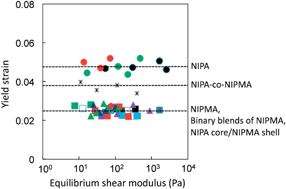A simple feature of yielding behavior of highly dense suspensions of soft micro-hydrogel particles†
Abstract
The highly dense suspensions of soft micro-hydrogels with a narrow size distribution (typically ϕeff > 0.9 where ϕeff is the apparent volume fraction of the particle), which form a regular lattice structure, exhibit a simple feature in the yielding behavior: the yield strain γc [ca. 2.5% and ca. 4.8% for poly(N-isopropylmethacrylamide) (PNIPMA) and poly(N-isopropylacrylamide) (PNIPA) hydrogel particles, respectively] is nearly insensitive to the cross-link concentration (cx), particle diameter (Dh), and particle concentration (c) in the limited c range examined here, and γc is almost constant in a wide range of equilibrium shear moduli over two orders of magnitude. In addition, no appreciable difference in γc is observed in the dense pastes with crystalline and glassy structures which are formed by mono- and bidisperse microgels, respectively. This is in contrast to a finite difference in γc for the crystal and glass formed by the hard sphere reported by Koumakis et al. [Soft Matter, 4, 2008 (2008)]. Furthermore, the highly dense suspensions of NIPA core–NIPMA shell microgels are similar in γc to those of NIPMA microgels. These results indicate that γc for the highly dense suspensions of soft micro-hydrogels depends primarily on the kind of constituent polymer near the particle surface. The yield strain γc is expected to be governed by short-range interactions such as adhesion and friction.


 Please wait while we load your content...
Please wait while we load your content...